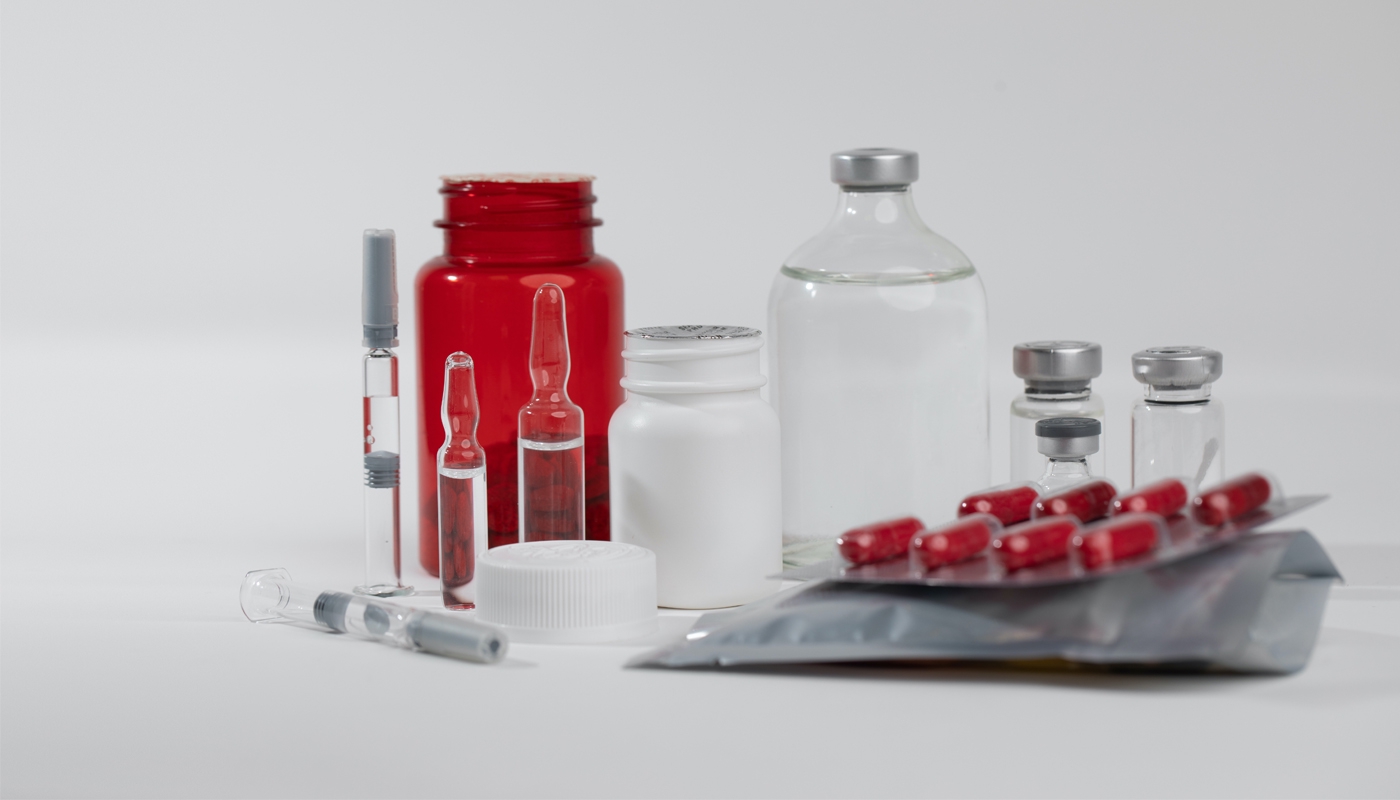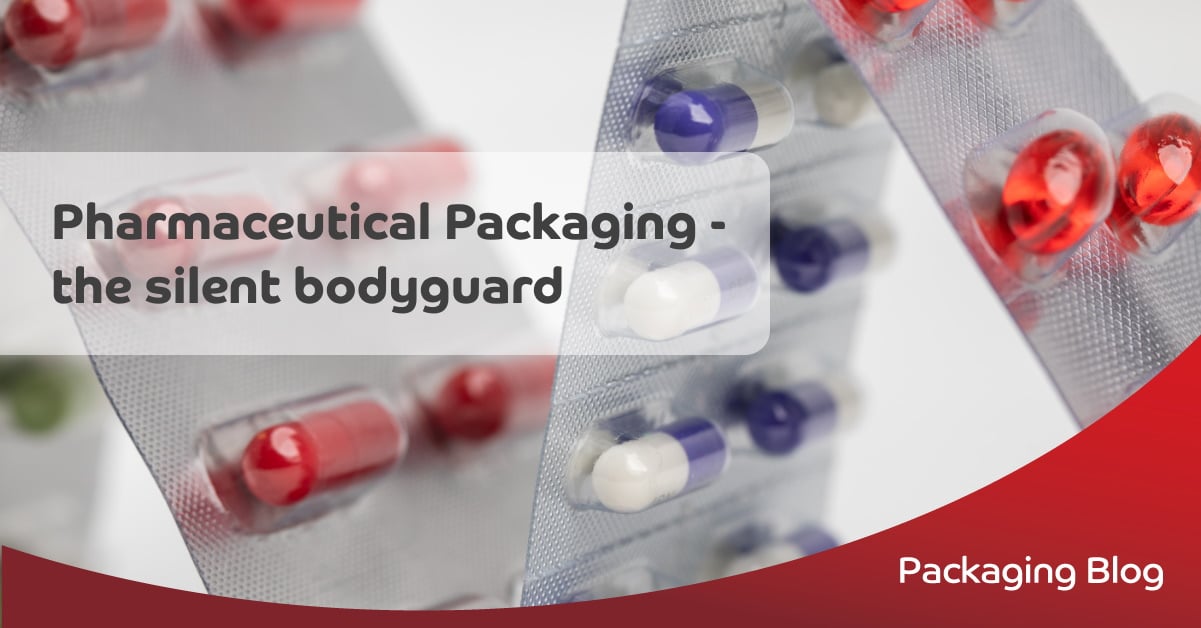
Pharmaceutical packaging: the silent bodyguard
In the world of pharmaceuticals, packaging performs many functions – from lending aesthetic appeal to ensuring patient compliance – but its overriding role is that of bodyguard; packaging needs to protect its valuable contents from moisture migration, oxidation, damage during transit and tampering.
Whilst pharmaceutical packers cannot ignore market trends and pressures, whether sustainability, traceability, personalisation or Industry 4.0, any changes to the way a product is packaged will only make it commercially if this protection guarantee can be upheld. Quality, patient safety and product integrity are everything in pharmaceuticals.
In this post, we will discuss trends in pharmaceutical packaging, including market performance, emerging packaging technologies and production line innovation, with an emphasis on blister packaging, which accounts for 80% of all pharmaceutical packs in Europe.
Pharmaceutical packaging market performance
Research and Markets predicts the pharmaceutical packaging market will grow to USD 178.1 billion by 2026, at a CAGR (Compound Annual Growth Rate) of 10.4%[1].
It lists India, China, and Brazil as the top growth markets, due to increasing populations, increasing disposable income, and rising focus on increasing life expectancy.
Estimates from other market research sources are broadly similar; a report from Allied Market Research projects that the market size will hit USD 144,233 million by 2027, based on a CAGR of 6.1%[2].
Increased R&D, innovation in packaging materials, advanced manufacturing processes to develop sustainable and eco-friendly packaging solutions and product innovations, growth in the generics market and increasing demand for convenient packaging including auto-injectors and pre-filled syringes are some of the key growth drivers.
COVID-19 implications
The pandemic crisis and global lockdown has seen reduced workforce, transportation restrictions and a shortage in the supply of components and raw materials. The shortage of raw materials and potential price inflation could restrain growth. However, global vaccinations and increased demand for primary packaging (e.g. inhaled, oral, transdermal, and injectable) are expected to drive growth of pharmaceutical packaging.
Pharmaceutical formats fight it out
All pharmaceutical packaging formats are experiencing growth, albeit marginal gains for some, such as glass bottles, which have lost share to other container types, notably plastic bottles, owing to cost and safety considerations.
Parenteral packaging such as pre-fillable syringes and inhalers are posting the most pronounced increases; data from the Freedonia Group indicated that the markets for both formats grew by over 50% between 2011 and 2016. Pre-filled containers are preferred by the medical industry because they are easier for healthcare professionals to use and safer for patients as they minimise the margin for dosing errors. Their rising popularity is also due to an increase in non-communicable diseases. Diabetics, for example, can self-administer a metered dosage.
The most prevalent pharmaceutical packaging formats in terms of market volume are plastic bottles and blister packs – they command the largest market shares by an overwhelming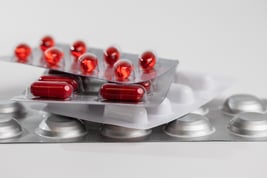 majority. There are marked geographical differences in demand for these formats; in the US, historically, there has been a strong bias towards bottles for packaging tablets and capsules. Although in recent years there has been a definitive shift towards blister packs, bottles still remain the dominant format, accounting for 80% of products dispensed.
majority. There are marked geographical differences in demand for these formats; in the US, historically, there has been a strong bias towards bottles for packaging tablets and capsules. Although in recent years there has been a definitive shift towards blister packs, bottles still remain the dominant format, accounting for 80% of products dispensed.
Blister packs: a pocket of growth
Marketsandmarkets projects that the blister packaging market size will grow from USD 24.1 billion in 2020 to USD 34.1 billion by 2025, growing at a CAGR of 7.2%[3].
Beroe, another market analyst, is slightly more conservative with its estimates; it valued the market at USD 15.22 billion in 2019 and expects it to hit USD 17.4 billion by 2024[4].
It predicts that blister packaging will account for 23-25% of the overall pharmaceutical packaging mix by 2024, growing its share from 18-19% in 2019.
North America and Europe are the biggest users of blister packs – according to Beroe, Europe represented 44% and North America 29% of global demand. Development in the healthcare system promotes the growth of blister packs in developing regions, like Asia, LATAM, Middle East, and Africa.
There are many reasons why blisters packs are so popular: besides providing opportunities for creating a visually and texturally appealing experience, blisters can reduce the risk of pharmacy dispensing errors and improve patient compliance.
There are quality advantages too. Blister packaging protects its contents from moisture, oxygen, light, heat and chemical migration. Whilst bottles also do this very effectively, once the bottle is opened and the contents are exposed to the atmosphere, the barrier is compromised. By contrast, with a blister pack, each individual tablet cavity protects the dose inside until it is removed from the packaging.
Material choices & considerations
Across all types of pharmaceutical packaging, plastics and polymers such as HDPE, LDPE, PET, PVC and PP are the dominant materials used. Plastic can be cost-effectively and easily formed into vials, bottles, syringes and blisters, plus it can be combined with metals such as aluminium to form laminations for flexible packaging.
For blister packs, the choice of forming and sealing materials depends on the degree to which the product needs to be protected from light, heat and moisture. Each material provides different resistance to each of these elements and will affect the shelf life and storage conditions of the packaged drugs. Stability studies are usually carried out during a drug's development to identify which materials are most suitable, bearing in mind the differing cost implications.
Thermoforming vs cold-forming
Thermoformed blister packs account for the lion’s share of the market and are growing at the fastest rate. The main plastic forming films used are PVC, PVDC (coated PVC), PP, PET, ACLAR and COCs (cyclo-olefin copolymers).
The other method of producing a blister pack is via cold forming using aluminium-based film (OPA-ALU-PVC). It is a more complex and costly process than thermoforming and is therefore usually reserved for products that are extremely sensitive to moisture, owing to its  ability to almost entirely eliminate water vapour permeability. Aluminium blisters work out at considerably more than PVC-based blisters – and not just because aluminium is a more expensive raw material. Cost per pack is also higher because the laminate foil possesses less formability, which leads to bigger cavities than needed for the product. This makes the whole blister package bigger, with a knock-on impact on secondary packaging and logistics costs.
ability to almost entirely eliminate water vapour permeability. Aluminium blisters work out at considerably more than PVC-based blisters – and not just because aluminium is a more expensive raw material. Cost per pack is also higher because the laminate foil possesses less formability, which leads to bigger cavities than needed for the product. This makes the whole blister package bigger, with a knock-on impact on secondary packaging and logistics costs.
The lidding material consists of support material that has a printed primer on one side and a sealing agent on the other. The most commonly used lidding foils are aluminum (for push-through blisters), paper-aluminum and paper-PET-aluminum (for peel-off push-through blisters).
The article below includes a Q&A to help decide whether an Alu Alu blister is right for your product or whether a cheaper thermoform blister would be as effective: Is an alu-alu blister right for my product?
Responding to the ‘Attenborough effect’
The anti-plastic sentiment that has swept the world since the broadcasting of the Planet II series unleashed a race for the development of the first ‘sustainable’ blister pack (conventional blisters cannot be recycled because of the complex laminates and multiple materials they are made from).
Early past the post was Huhtamaki, with a recyclable strip-packaged blister for pharmaceutical solids. Pitched as a sustainable alternative to conventional blister and cold form packaging, the innovation was developed in collaboration with strip pack machine manufacturer Romaco Siebler.
Made from recyclable polyolefin laminate, the Push Pack is said to fulfil the Blueloop criteria for sustainable packaging, which stipulates the use of more than 90% components of the same material class, a primary packaging recycling rate in an existing and proven recycling process of more than 70%, and the absence of PVC, PVDC and PS (or EPS). The packs are said to be up to 60% cheaper to produce than alu-alu blisters.
On the face of it, the pharmaceutical industry is lagging behind other industries such as food in the development of sustainable packaging solutions. But the reason for the lack of ‘green’ pharmaceutical packaging innovation comes backs to the fundamental role that packaging plays in this industry - that of product protector.
In the blister packaging arena, plenty of companies are researching options for sustainable materials, but the challenge is trying to match the sterility, performance and protection characteristics of conventional materials. Unless a manufacturer has irrefutable evidence that a new material will not compromise the efficacy of a drug or the sterility of a pack, they will not pursue it. Even if test data is promising, there are numerous regulatory hoops to jump through before a new packaging format can be introduced.
It is true that the pharmaceutical industry is risk averse and usually one of the last to adopt new processes and technologies, but this is the way it has to be if it the industry is to maintain consumer trust in the safety, quality and efficacy of its products.
All of this conspires to make it difficult for pharmaceutical manufacturers to switch to more sustainable materials.
A dose of innovation
Still, packaging innovation is gathering pace in the pharmaceutical industry, as the proliferation of generic OTC products and an increasingly competitive marketplace prompt the big pharmaceutical players to use packaging as a marketing tool. Designs that improve patient compliance, tackle child resistance or combat counterfeiting are also in demand.
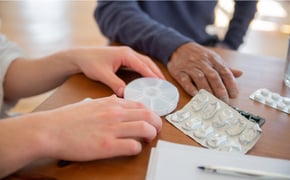 In the blister packaging space, innovations are mainly centered on enhanced barrier protection. Tekni-Plex has come up with its strongest barrier yet for pharmaceutical blister films in the form of its SBC (Super Barrier Coated) 240 PVDC-coated PE film. Designed as a lower cost alternative to 4- and 6-mil PCTFE or cold-formed foil, the triplex material offers an ultra-high barrier to moisture and oxygen and eliminates the need for stiffening ribs as well as the larger blister wells needed for cold forming.
In the blister packaging space, innovations are mainly centered on enhanced barrier protection. Tekni-Plex has come up with its strongest barrier yet for pharmaceutical blister films in the form of its SBC (Super Barrier Coated) 240 PVDC-coated PE film. Designed as a lower cost alternative to 4- and 6-mil PCTFE or cold-formed foil, the triplex material offers an ultra-high barrier to moisture and oxygen and eliminates the need for stiffening ribs as well as the larger blister wells needed for cold forming.
Other technologies for protecting moisture-sensitive products include desiccated blister packaging solutions that claim to have the edge over aluminium blisters. Amcor’s Formpack Dessiflex Ultra and Aptar CSP Technologies’ Activ-Blister are two examples.
Smart electronic technologies are also being applied in a blister packaging context, although this is very much in its infancy. Schreiner MediPharm collaborated with ECCT to develop a smart blister pack for patient compliance monitoring in clinical trials. When a tablet is pushed out of the pack, data is generated and can be transmitted to a database via smartphone app or reader. Other ‘smart’ applications include the incorporation of sensors or PCBs (Printed Circuit Boards) within blister packs to monitor in-cavity conditions throughout a product’s shelf life.
The Huhtamaki recyclable blister example above also reflects a trend towards creating all-film blisters on strip packaging machines. Another example of this approach is the Constantia Flexible Blister. According to an article in Contract Pharma magazine (January 2019), this pack runs on conventional strip packaging equipment and offers barrier properties and push-through opening similar to traditional thermoform blister packs.
Blister packaging machines
The vast majority of blister packs are produced on high speed form, fill, seal machines designed by the likes of Uhlmann, Romaco, MediSeal, Marchesini and IMA.
There are two sealing techniques: intermittent sealing with plates (platen) and continuous sealing with rollers (rotary). Whereas systems with continuous rotary sealing are more efficient on long runs of standard blisters, the principle of intermittent sealing allows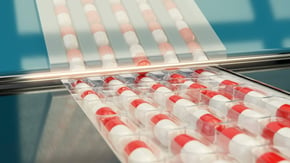 contract manufacturing organisations to carry out several changeovers during the course of a shift. Inevitably, continuous machines occupy more space than intermittent machines because they incorporate additional parts such as a series of draw through rollers. Top spec continuous machines can process up to 800 blisters per minute, although speeds are very much product dependent, and whilst easy-to-feed products such as flat tablets can run at very high speeds, products with demanding geometries, such as syringes, require slower packaging speeds. As well as the ‘minimum’ forming, sealing, cutting and coding stations, most blister packaging machines will also incorporate print mark registration, online printing, foil buffer systems, cold forming for alu-alu blisters, in-process control systems and laser pocket detection.
contract manufacturing organisations to carry out several changeovers during the course of a shift. Inevitably, continuous machines occupy more space than intermittent machines because they incorporate additional parts such as a series of draw through rollers. Top spec continuous machines can process up to 800 blisters per minute, although speeds are very much product dependent, and whilst easy-to-feed products such as flat tablets can run at very high speeds, products with demanding geometries, such as syringes, require slower packaging speeds. As well as the ‘minimum’ forming, sealing, cutting and coding stations, most blister packaging machines will also incorporate print mark registration, online printing, foil buffer systems, cold forming for alu-alu blisters, in-process control systems and laser pocket detection.
The article '8 Top tips for achieving a brilliant blister seal' details tips on how to achieve and maintain an excellent blister seal.
Short runs, serialisation and digitisation dictate design
There will always be a need for large machines dedicated to a single product for mass-producing blockbuster drugs and generic products that have come off patent. However, JIT (Just In Time) manufacturing, the emergence of personalised medicine and a shift from low-cost drugs for large populations to high value, targeted therapies are driving the expansion of low-volume production.
This has spawned innovation in mid-performance blister packaging lines that can cope with frequent product changes, different blister layouts and relentless time and cost pressure.
These machines feature quick interchangeable forming and cutting tooling and servo technology to minimise time between product and blister format changeovers.
The requirement for serialisation, driven by the Falsified Medicines Directive (2011/62/ EU), has created new challenges for the pharmaceutical packaging industry. Whilst the holy grail is to track every single tablet individually, at present, most pharmaceutical manufacturers are targeting unit-level serialisation. This means that every carton – or, better still, every blister – needs to carry a unique code that can be read by verification devices such as a vision system. For secondary packaging such as transit cases, an aggregation must be created, where the unique code on the blister/carton is tied to the code on the case.
Industry 4.0, sometimes called the IoT (Internet of Things), is a transformation that is already well underway in the pharmaceutical industry, with IoT software and services already a big business and packaging machinery designers rolling out Industry 4.0 programmes. Essentially, Industry 4.0 is about integrating sensors, machines and IT systems along the value chain so that these connected systems can interact with one another via standardised Internet-based communication protocols. This opens the door to exciting possibilities such as machine learning, condition monitoring, remote-access monitoring and, ultimately, the smart factory in which operations are carried out with minimal manual intervention and maximum efficiency.
On a blister packaging line, for example, incorporating a smart component that can detect wear to the sealing plates can prevent downtime by pre-empting their replacement. The entire ordering process will happen automatically – from generation of a purchase order to shipping from the supplier.
Over the next few years we predict that Industry 4.0 capabilities will become more prevalent on blister packaging lines. This will most likely happen by default as component manufacturers produce Industry 4.0-ready parts that are introduced into line equipment.
Certainty in uncertain times
In a world of uncertainty, the future of blister packs is assured. The next few years will inevitably see some changes – the introduction of new materials for sustainability, cost and functionality reasons, and innovation in blister packaging equipment for smaller batches, to name but a few. However, blister packaging’s primary role, that of silent bodyguard, will remain paramount.
[1] Global Pharmaceutical Packaging Market By Material, By Product, By Region, Industry Analysis and Forecast, 2020 - 2026
[2] Pharmaceutical Packaging Market by Product Type - Global Opportunity Analysis and Industry Forecast, 2020–2027
[3] Blister Packaging Market by Material and Region - Global Forecast to 2025
[4] Blister Packaging Market Intelligence
Sepha Solutions
Founded in 1980, Sepha has established a global reputation for innovation and development of specialised, high-quality equipment for use in the manufacture of pharmaceutical blister packs, parenterals, medical devices and healthcare products.
- We offer a range of small scale, high quality blister packaging machines and medical device packaging solutions capable of handling all thermoform and cold-form materials. The EZ packaging range offers high quality packs for all requirements including child resistant/peelable blister packs, medical devices and monitored unit dose packs.
- In addition we offer a range of non-destructive and deterministic CCIT and leak test systems, specially designed to rapidly test for leaks in a wide variety of pharmaceutical packaging including blister packs, vials, ampoules, pre-filled syringes, BFS strips, bottles, sachets, pouches and medical devices. Unlike the industry standard destructive test methods like Blue Dye Methylene, our testing methods are non-destructive in line with ASTM standards and deterministic as preferred in USP 1207.
Other interesting articles:
- '8 Top tips for achieving a brilliant blister seal'
- 'Is an alu alu blister the best choice for your product'
- 'Is blue dye letting you down in your green efforts?'
- 'CCIT of blister packs'
- 'Is USP 1207 relevant to blister leak test procedures?'
- 'Experience the future of bister leak detection'
